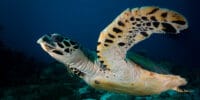New App Aims To Help Endangered Turtles
A new App is able to spot real from fake tortoiseshell which will hopefully help in the fight against the illegal trade in turtles.
Critically endangered hawksbill’s
Tortoiseshell is both durable and visually appealing and has been used for centuries to make jewellery and household items. However, tortoiseshell doesn’t come as you might think from tortoises. It almost exclusively comes from the critically endangered hawksbill turtle.
In the hundred years between the 1880’s and the 1990’s it is thought that over 9 million hawksbills were killed and sold for their shells. That has had a catastrophic effect on their numbers. Today there are thought to be less than 25,000 breeding females in the world. Their commercial trade has been banned.
SEE Shell App
The app is called SEE Shell, and has been developed by the turtle conservation group SEE Turtles and the Smithsonian Science lab. The app can identify the difference between real or fake tortoiseshell by the patterns. The user uploads a photo of the tortoiseshell item and the app will say if the item is real or fake. The app is aimed at both consumers and law enforcement. In the case of the consumer, they can then avoid buying real tortoiseshell in the hope that the trade then collapses given the consumer is avoiding it.
Illegal sales in tortoiseshell continue in at least 40 countries, largely in Central America and Southeast Asia. Souvenir and gifts bought by travellers and holiday makers makes up the majority of sales.
Identifying trade patterns
The app will also be useful for SEE Turtles to be able to identify where the hot spots are for the illegal trade. Each time an image is uploaded it is stored on a central database with GPS coordinates added. This will greatly help establish what the trade patterns are globally for illegal tortoiseshell.
The app was created by training a computer to understand the difference between fake and real tortoiseshell. Over 4000 images or both fake and real tortoiseshell products were put in to the computer. They were analysed and the subtle differences between real and fake were recorded so that the computer can spot the difference to 94% accuracy. The key difference is that the fake pattern is often uniform whereas real tortoiseshell is random.
Aiding law enforcement
Due to identifying real from fake items being so hard until now, law enforcement has often been impossible. Often crack downs on illegal trade is only made if an expert accompanies the authorities.
Now the law enforcement authorities can work independently and quicker, which will be invaluable.
The WWF are also offering support to SEE Turtles in an effort to bring the technology inside online platforms. In recent years platforms such as Facebook, eBay and others have been trying to detect listings of illegal wildlife items. Usually this is done by detecting prohibited keywords, however know it might be possible to prevent listings using the visual technology. The tech could be extended further and used to detect real bone from fake. If capable of being able to detect actual ivory it would be particularly valuable, however that is trickier than identifying tortoiseshell.


